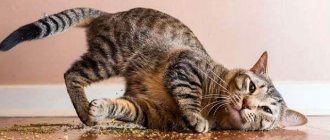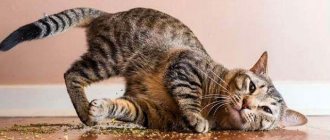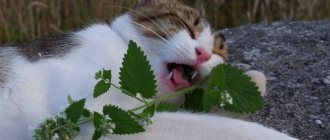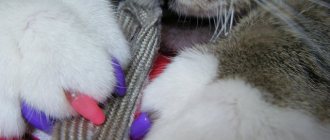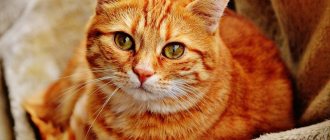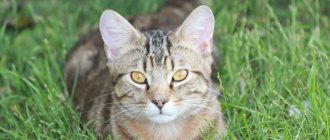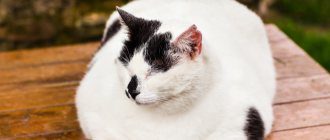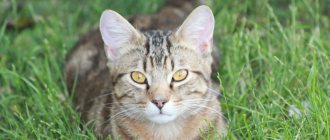Why do cats love valerian so much? A medicine made from valerian root is found in every home medicine cabinet, and people do not consider it necessary to hide this harmless sedative. But as soon as a cat appears next to the odorous composition, the danger increases to gigantic proportions.
These animals adore valerian and do not suspect the risk to their health and psyche.
Why cats love valerian and what happens to them
The specific reaction of animals to substances containing valerian root is known mainly from practical observations. Valerian for cats is an energy drink, a sleeping pill, and a deadly drug in one bottle.
And everything happens in exactly this order:
- after taking valerian, the cat experiences a short period of hyperactivity;
- then the pet becomes lethargic and drowsy;
- and if the cat does not wake up for a long time - sometimes up to 2 days - you need to invite a veterinarian and save the animal.
Calm, only calm: the healing properties of valerian
Valerian owes its name to the Italian botanist Matteo Silvatico, who lived at the turn of the 13th - 4th centuries. It was he who, in his book, first used the Latin word valeriana to designate a plant, forming it from another Latin word valere, which means “to be healthy.”
Today, valerian is used to flavor Cuban cigars and some varieties of Turkish tobacco, added as a spicy additive to liqueurs and alcoholic tinctures (for example, Russian Greyhound balm), and a salad made from its fresh leaves is used to garnish fish dishes in English restaurants. But the main value of the plant still lies precisely in its medicinal properties, for which valerian is cultivated in many countries around the world.
Photo gallery: mountain grass (valerian)
Valerian flowers (from white to dark pink) are collected in “umbrella” inflorescences
The lower leaves of valerian are located on the petioles, and the upper ones “sit” on the stem
Cord-like roots of the plant contain up to 2% valerian essential oil
Due to the medicinal properties of valerian officinalis, it is cultivated in many countries.
Preparations from valerian (extracts, tablets, powders, decoctions and tinctures) are used in medicine (and veterinary medicine) primarily as sedatives (sedatives) and antispasmodics. They are indicated for neurosis, insomnia, spasm of the coronary vessels or gastrointestinal tract, as well as for migraines, asthma and epilepsy.
The healing properties of valerian (as valerian preparations are usually called) are due to the alkaloids and essential oil contained in the plant, which include:
- bornyl isovalerate;
- isovaleric acid;
- borneol;
- camphene;
- alpha-pinene;
- limonene.
And here’s what’s interesting: substances that effectively calm the nervous system of humans, dogs, horses, pigs, cows and even chickens have a diametrically opposite effect on members of the cat family.
Why cats love valerian: the general process
Cats love valerian because it contains actinidin (a group of pheromones). Pheromones form behavioral algorithms associated with social and genetic processes. Cats like valerian for a completely natural reason - it works as an amplifier of “friend or foe” signals.
It sounds complicated, but in reality it looks much simpler. It is enough for an animal to sniff a drug containing actinidin, and its brain receives a signal about the close presence of representatives of a related tribe.
Valerian for cats is an impulse to mark territory, take a dominant position on it and show sexual desire.
Groups of inhalation drugs:
- Antiseptics (Furacilin, Dioxidin, Miramistin)
- Antibiotics (Gentamicin, Tobramycin)
- Anesthetics (Lidocaine)
- Hormonal drugs (Cromohexal, Budesonite, Pulmicort, Dexamethasone)
- Immunomodulators (Interferon, Derinat)
- Mucolytics (Fluimucil, Lazolvan, Ambroxol, Ambrohexal, Pulmozyme, Acetylcysteine)
- Bronchodilators (Berodual, Fenoterol, Ventolin, Berotek, Salamol)
- Herbal medicine (Rotokan, Tussamag, Chlorophyllipt)
- Vasoconstrictors (Adrenaline, Naphthyzin)
- Alkaline and saline solutions (0.9% saline)
The effect of valerian on cats: the similarity of the smells of feline and actinidin
To understand the mechanics of the process in more detail, you need to remember such a component of cat marks as feline. It is found in the urine of sexually mature individuals and serves as a natural marker. The reason cats love valerian lies precisely in the similarity of two fragrant aromas: feline and actinidin.
Animals simply confuse them.
Well, subsequent excitement is just a natural reaction of the body to the presence of a stranger cat nearby. Instincts and behavioral stereotypes come into play.
The animal mechanically performs a ritual programmed by nature. This is due to the almost identical effect of valerian on cats in all cases.
Valerian acts on cats for a limited period of time. Due to the too high concentration of actinidin, it causes a violent reaction and quickly takes away the animal’s strength, putting it into a state of apathy and drowsiness.
Is it possible to accustom a cat to a litter box or scratching post using valerian?
There are many negative effects that occur when consuming valerian.
As already mentioned, the drug may cause your pet to experience hallucinations. Because of this, the pet will be very frightened and may remain in a state of panic for more than one day. The animal will flinch because of any sound, and the nervous system will be shaken. The alcohol tincture immediately causes addiction in the pet. In this case, the cat may begin to constantly ask the owner for a new dose. Some animals become extremely aggressive, while other pets become nervous and fearful. At the same time, do not forget about the likelihood of an allergic reaction, kidney and liver diseases, as well as stomach problems. You shouldn’t ruin your pet’s body for fun by giving him valerian.
Animals become more agitated than usual. They can cause chaos in the house, run and jump, attack a non-existent enemy, which is explained by ordinary hallucinations. Your pet's character changes beyond recognition. An early calm and sweet cat can prove to be an incredible rowdy.
In addition to all this, ethyl alcohol occupies most of the volume in valerian tincture. Cats' bodies are unable to process alcohol. For this reason, animals become addicted literally “from the first drink.” In addition, if you overdo the dose or pamper your cat with alcohol too often, his liver may not be able to cope at all. You will have to resort to the help of veterinarians and expensive treatment.
Does it affect everyone the same: the effects of valerian on different cats
All animals react to the drug individually:
- A third of cats do not feel the effects of valerian. For them it is a normal smell, unremarkable and neutral. Even a kitten under the age of six months will not show interest in him - he is still far from reaching sexually mature instincts. Siamese cats will not be impressed by valerian. This breed does not react to actinidin odors.
- Another 30% express an average degree of involvement - short-term activity is replaced by an equally quick rest and return to normal behavior.
- The remaining group is a riotous madness. Valerian should not be given to such cats. The animal will experience severe emotional stress and a long period of rest.
The final group is at risk due to the “valerian hangover” syndrome. As soon as he comes to his senses, the cat will begin to look for the source of the remembered smell.
The active ingredient of valerian has a stronger effect on male cats. The fact is that the feline content in their urine is 4 times higher than in cats.
How does an animal's behavior change under the influence of valerian?
Valerian has a sedative and hypnotic effect on humans. Knowing this, some owners make the mistake of giving their cats valerian and hoping that this will calm them down. Valerian has a completely different effect on animals. It has a stimulating effect on their nervous system and makes them even more active.
It is interesting that adult cats react to valerian in much the same way as males, but kittens are insensitive to it.
Some cats become affectionate after valerian, rubbing against their owners’ legs, demanding to be stroked and picked up. Others begin to run around the apartment and meow loudly. This is how animals manifest sexual arousal, which makes them look for a partner and call for him with a loud meow. Often, such overexcitation causes severe aggression in cats, and they begin to rush at their owners, scratching and biting.
This hyperactivity lasts from 20 minutes to half an hour, after which a stage of apathy and exhaustion sets in. Cats become lethargic and indifferent, after which they fall asleep and can sleep for many hours in a row.
Behavior of cats after taking valerian: symptoms and consequences
Two categories tolerate contact with the drug quite neutrally, and they do not experience discomfort after the cessation of its action. Representatives of the first group simply avoid the intrusive odor, while the second easily tolerate both the active stress phase and the passive exit from it.
Things are worse for animals from the third group. It will not be difficult to give such a cat a drink of valerian. But to return it to normal, you will have to make an effort.
In addition to long sleep, the following will appear:
- symptoms of poisoning;
- lack of coordination of movements;
- apathy, indifference to games and communication;
- lack of interest in food or physical inability to eat it.
Sometimes, due to the use of valerian, aggressive habits develop and the character of the animal changes.
For cats, valerian is a highly dangerous drug. It is risky to offer it to your pet without a good reason and a veterinarian’s prescription.
Is it possible to give a cat valerian: medicine or poison?
Much depends on the form of the drug. It is produced for humans and is therefore available in 3 forms: tincture, tablets and dry herb collection.
- If prescribed by a veterinarian, the cat is given a dried herbal composition - it is safer than others.
- In the absence of a decoction from a collection of dry herbs, valerian in tablets is preferred. In this case, allergies and mild malaise are the most expected and harmless consequences. Therefore, if you decide to give valerian in tablets, you should take into account that the medicine includes synthetic components.
- The most powerful effect will be if the cat is given valerian in alcohol. Cats do not have an enzyme that breaks down alcohol in their bodies, so they will get used to ethyl quickly. Giving cats an alcohol solution of valerian is strictly prohibited. Even a small dose received by licking can have a devastating effect on the internal organs of the animal.
Valerian tablets need to be ground into powder for a cat - if you give a whole piece, it will take a long time to dissolve in the gastrointestinal tract.
Benefits of valerian
Valerian is useful for cats only with a prescription from a specialist for the following medicinal purposes:
- correction of thyroid disorder;
- treatment of gastrointestinal diseases;
- stimulation of cardiac muscle activity;
- (sometimes) stimulating sexual activity in young animals during the first mating.
The benefits of valerian for a cat are clearly visible in stressful situations when transporting long distances: it calms the animal and makes it less susceptible to external irritating factors.
Valerian can have a calming effect on a cat.
Is valerian harmful for cats?
No permanent negative effects of the drug have been reported. The harm or benefit of valerian for a cat is always determined by the individual characteristics of the body.
- Some animals experience swelling of the mucous membranes from the first use.
- Valerian is more harmful to male cats due to excessive stimulation of sexual desire.
Composition and release form
The pharmaceutical industry produces valerian in tablets, drops, in the form of an alcohol tincture, and also as part of soothing preparations, where the raw material is presented in crushed form for subsequent preparation of a decoction. Any of these dosage forms are of interest to the cat, so if you have a bottle of valerian in your house, sooner or later your pet will definitely get to it.
The following release forms exist.
Valerian tincture is available in the form of drops for oral administration; the medicine is packaged in dark glass bottles of 15, 25, 50 or 100 milliliters. 80% of its volume consists of 70% ethyl alcohol, and the rest is dry valerian root powder. In the composition of the drops, the role of the active medicinal substance is performed by extracts of the essential oil of the plant, consisting of borneol and isovaleric acid, and plant alkaloids have an antispasmodic and calming effect: valerine, valepotriates and hotein.
The raw materials obtained from the root of medicinal valerian are used in the manufacture of sedatives that normalize a person’s psycho-emotional state, help him fall asleep faster, reduce nervousness and irritability, relieve spasms, and improve the functioning of the gastrointestinal tract. Valerian root has an absolutely opposite effect on the body of domestic felines, causing excessive motor activity, euphoria and hallucinations in animals, accompanied by inadequate behavioral reactions.
The animal's state of intoxication lasts for a fairly short period of time - from 5 to 15 minutes, and then it begins a phase of deep and sound sleep. During sleep, all the smooth muscles of cats relax, including the respiratory system, so veterinarians know of frequent cases when a furry pet, having fallen asleep, could no longer wake up.
How much valerian can you give a cat?
The amount of valerian that can be given to a cat is calculated based on its weight, size, physical condition, temperament and diagnosis made by a veterinarian.
When self-treating, it is not recommended to let the animal out of sight until it has fully returned to normal active activities. Any deviation from the norm is viewed with a negative assessment - even in small quantities, the effect of valerian on cats is unpredictable.
Before using the medicine, the animal should be fed. Giving a cat valerian on an empty stomach is strictly not recommended.
Overdose symptoms
Characteristic features of the negative effects of the drug are visible from external signs of behavior or changes in habits:
- Toxic damage. Profuse salivation begins, foam appears around the mouth, vomiting and convulsions occur. The development of the process moves towards the respiratory organs and cardiac muscle. Severe spasms and stroke are possible.
- Persistent aggression, rapid mood swings, changes in socialization markers. For a cat, valerian becomes the goal of an incessant search, and its absence puts the animal out of psychological balance.
- Damage to internal organs. The first sign is blood in the urine and feces, manifestations of painful sensations. Often characterized by prolonged stomping in one place and purring. In this way, the animal independently produces an analgesic hormone and tries to overcome physical suffering.
Any differences from standard behavior should be a reason to immediately contact a veterinarian.
What can be replaced: a harmless alternative
It is not necessary to deprive your pet of the joy of short-term hormone production. Valerian does not possess this quality alone - its substitutes are both gentler and safer.
We are talking about plants that are informally grouped into the catnip group:
- catnip;
- budra;
- common scent.
Having found such a bush, cats begin to rub against it, trying to damage the stem and lick the odorous juice. But the harm of this liquid is not commensurate with the effect of valerian, and the arousal effect passes quickly and without consequences.
Catnip is often used as a filler in toys or sold separately in pet stores. And if you buy it, you won’t have to risk your pet’s life to give him a couple of extra minutes of joy.
Description of medicinal valerian
As long as humanity has existed, it has known about the medicinal properties of valerian. The roots of this plant, which were used by healers of ancient Greece, Rome, Egypt, India, and the Ancient East, are especially valued.
Valerian is the scientific name of the plant and is popularly called cat grass, cat root or mount grass. This is explained simply: its smell is very attractive to cats and has a special effect on them. It belongs to the family of perennial herbs and loves to grow in lowlands, near ponds, and in wetlands.
Visually it looks like this:
- Not only does it have a tall stem, which can reach 2 meters in height, but it is also very thick.
- The flowers are pinkish in color and are collected in an umbrella.
- The root system is loose, short, with many branches.
As soon as cats smell the smell of this plant, they immediately gather near it and begin to roll around in order to damage the integrity of the stem. Then they begin to lick the juice released on the surface of the stem.
Under the influence of the juice, they begin to roll on the ground even more, jump and scream loudly. Valerian has a stimulating effect on them, although people take this remedy, on the contrary, to calm them down.
